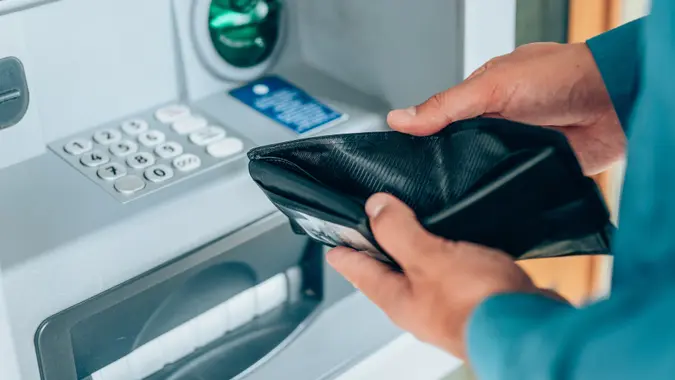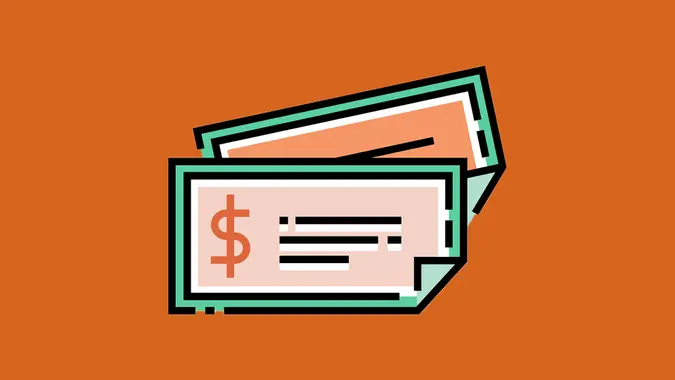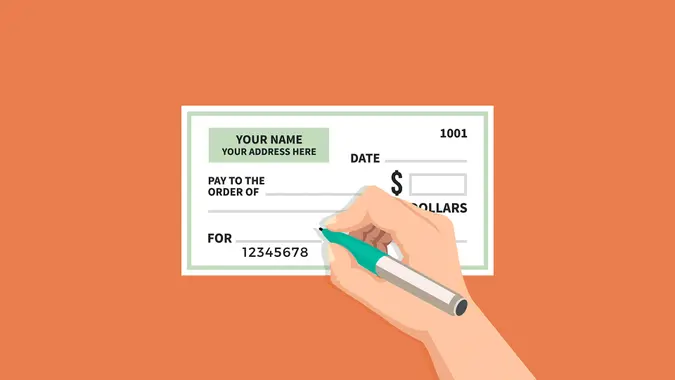Types of Checking Accounts: Which One Is Right for You?

Commitment to Our Readers
GOBankingRates' editorial team is committed to bringing you unbiased reviews and information. We use data-driven methodologies to evaluate financial products and services - our reviews and ratings are not influenced by advertisers. You can read more about our editorial guidelines and our products and services review methodology.

20 Years
Helping You Live Richer

Reviewed
by Experts

Trusted by
Millions of Readers
There are several types of checking accounts to choose from, including basic, joint and specialty options. Some offer rewards or interest, while others are built for students, seniors or those rebuilding their finances. The right account can help you save money and match how you bank — online, in person or both.
Here’s a breakdown of 11 different types of checking accounts, their key features and who they’re best for.
Standard Checking Account
Best for: Everyday access to funds
This account is the most common. It allows you to access money via checks and a debit card. You may also have the following features:
- No minimum deposit
- Monthly fee but can be waivable
- Online bill pay
- FDIC-insured up to $250,000 per depositor
- Unlimited transactions
- Typically no interest earned on balances
Student Checking Account
Best for: Students opening a first checking account
A student checking account is great for young high school or college-age students. Here are some of the features that make this account ideal:
- No monthly minimum balance
- Comes with debit card access
- No monthly fees — as long as you qualify as a student
- Online and mobile banking access
- FDIC-insured up to $250,000 per depositor
Joint Checking Account
Best for: Couples managing their accounts together
A joint account allows two or more individuals to share access to money. Here are the key features:
- Shared access for two people to deposit, withdraw and manage funds
- Equal legal access for all account holders
- Individual debit cards, checkbooks and online banking for each owner
- FDIC-insured up to $250,000 per depositor
- Joint responsibility for overdrafts, fees and negative balances
Interest-Bearing Checking Account
Best for: Savers who keep a high balance
Like savings accounts, these checking accounts earn you interest on your balance. The rates are typically lower than savings accounts. Here are key features:
- Interest earned on balances — typically lower than savings but higher than basic checking
- Minimum balance requirement — usually $1,000 to $2,000
- May have a maintenance fee
- Debit card and ATM access
- Some accounts offer tiered interest rates based on balances
- Online and mobile banking options
- FDIC-insured up to $250,000 per depositor
Business Checking Account
Best for: Those who have or are starting a business
Business checking accounts are built for businesses to manage deposits, expenses, payroll and more. Here are key features:
- Supports business income, expenses, payroll and vendor payments
- Usually requires an employer identification number (EIN)
- Check writing capabilities and debit card access
- Some accounts have transaction limits
- Monthly deposit limits before fees may apply
- FDIC-insured up to $250,000 per depositor
Rewards Checking Account
Best for: Frequent debit card users
Each rewards checking account comes with its own rewards scheme and structure. These are key features:
- Perks like cash back, high interest or rewards points for qualifying activity
- Above-average interest rates on some accounts
- Reward qualification requires minimum debit card use, direct deposits or e-statements
- No or low monthly fees
- Full access to banking features
- FDIC-insured up to $250,000 per depositor
Second-Chance Checking Account
Best for: Those who need to rebuild after banking issues
For those with past overdrafts or account closures, second-chance accounts offer a fresh start. Here are some of the features:
- Designed for people with poor credit
- Lower barriers to entry — poor credit isn’t a bar
- Fewer perks than a standard checking account
- Monthly fee in most cases
- Includes a debit card
- Online and mobile access
- Option to graduate to a standard checking account
- FDIC-insured up to $250,000 per depositor
Online-Only Checking Account
Best for: Those who do not need branch access
With no physical branches, these accounts often skip monthly maintenance fees and offer robust mobile tools. Here are other key features:
- Account opened, managed and used entirely online
- No minimum balance, overdraft fees or monthly maintenance fees
- High ATM accessibility
- Use of mobile tools
- Support for Zelle, ACH transfers and bill pay through app or web portal
- FDIC-insured up to $250,000 per depositor
Senior Checking Account
Best for: Individuals 55 years or older
These accounts often waive fees and offer perks like free checks or loan discounts. Here are some features:
- Available for individuals 55 years or older
- Low or no monthly maintenance fees
- May include complimentary checks
- Some senior accounts earn interest
- Debit card access
- Online and mobile banking
- Some accounts offer free checks
- FDIC-insured up to $250,000
Premium or Private Bank Checking Account
Best for: High-net-worth individuals
These accounts are suited for high-net-worth individuals who want individualized attention from a personal banker. These are some of the key features:
- Personalized service from a private banker or wealth advisor
- Higher limits for transfers, withdrawals and mobile check deposits
- Expedited access to customer service
- Waived fees for ATM use, overdrafts, wire transfers and foreign transactions
- Interest-bearing accounts with tiered APYs based on balance
- Additional perks like travel benefits, identity protection or concierge services
- High balance requirements — $25,000 to $250,000 — to open or avoid monthly fees
- FDIC-insured up to $250,000
Checkless Checking Account
Best for: Digital-first users
This option is a streamlined, digital-first checking account for managing money without paper checks. Here are key features:
- No paper checks
- Includes debit card access
- Mobile and online banking
- Often no minimal balance
- No overdraft penalties
- Simplified account with limited features to help avoid overspending
- FDIC-insured up to $250,000
Beyond Traditional Checking: Other Account Types
While traditional checking accounts work for everyday banking, there are other options that may offer more benefits depending on your needs.
Money market accounts earn interest like savings accounts but still allow check writing and debit card access. These hybrid accounts combine features of both checking and savings — often with fewer fees and higher APYs.
11 Types of Checking Accounts: At a Glance
| Type | Best For | Common Features | Monthly Fees |
|---|---|---|---|
| Standard checking | Everyday needs | Debit card, ATM access, bill pay, mobile banking | $0 to $12, can be waived |
| Student checking | High school or college students | No or low fees, mobile tools, low balance requirements | Usually $0 |
| Joint checking | Good for couples, multiple account owners | Multiple debit cards, shared access, co-ownership | $0 to $15, varies by bank |
| Interest-bearing checking | Users with large balances who want to earn interest | Earns APY, debit card, tiered rates, often requires minimum balance | $5 to $25, waivable |
| Business checking | Business owners and those want to start a business | EIN-based account, employee access, transaction limits, invoicing tools | $10 to $30, can be waived |
| Rewards checking | Those who want to earn extra perks because they frequently use their debit card | Earns cash back, interest or points, comes with activity requirements | $0 to $10, waived with activity |
| Second-chance checking | Those with poor banking history | Basic digital access, debit card, limited features, no overdraft | $5 to $15, typically not waivable |
| Online-only checking | Digital-first users | Free ATMs, mobile check deposit, no branch access | $0 to $5 |
| Senior checking | Adults age 55 or older | Fee waivers, free checks, interest, paper statements | Often $0 or discounted |
| Premium checking | High-net-worth individuals | Concierge service, fee waivers, integrated wealth tools | $25 to $50, waived with high balances |
| Checkless checking | Basic banking with no check writing abilities | No paper checks, debit card, online bill pay, no overdraft option | Usually $0 |
How To Choose the Right Checking Account
You should evaluate what works for your finances before choosing a checking account. Consider these factors:
- What are your banking habits? Do you prefer going in person or managing your finances online? Are you interested in extra rewards? How do you feel about monthly fees?
- Check out fees. Look at monthly maintenance fees, ATM fees, overdraft charges and foreign transaction fees.
- Prioritize convenience. Consider things like ATM access, mobile apps and online tools.
- Assess the different account types. Are you looking for basic checking? Do you want to earn interest? Are you a student or a retiree?
- Does the account come with FDIC or NCUA insurance? Ensure your money is being protected.
How To Open or Switch to a New Checking Account
It is easy to open or switch to a new checking account. Here is a step-by-step guide:
- Step 1. Compare account options: Research banks and credit unions that meet your needs. Decide which type of account fits your lifestyle.
- Step 2. Gather your documentation: You will likely need your government ID, Social Security number and proof of address.
- Step 3. Apply in person or online: You will be required to fill out an application and choose features you prefer on your account.
- Step 4. Make a deposit with funds: You can make your minimum deposit with a check, cash or external account.
Closing a Bank Account? Here’s What To Check First
Found a new account and ready to close your old one? Here are a few steps to take before making it official:
- You should wait a few months before closing your old account.
- Monitor the account for any unexpected payments or charges.
- Confirm that all automatic payments have been updated or canceled.
- Close the account once everything is clear.
Final Takeaways
There is a checking account out there to match your lifestyle — whether you need a basic account, a joint account, one that earns interest or a business checking account. Each bank offers its own mix of features, so it’s worth comparing options to find one that aligns with your financial habits and goals. Some may even offer promotions or bonuses for new customers.
Think about how you like to bank. If you’re tech-savvy, an online-only bank may suit you best. Prefer a more personalized touch? A bank with local branches may be a better fit. Let your financial habits guide your choice.
FAQ: Choosing and Managing a Checking Account
Still have questions about checking accounts? Here are some quick answers to help you choose the right one.- What are the different types of checking accounts?
- There are several types of checking accounts — standard, joint, student, business, interest-bearing and rewards checking.
- What are the three main types of checking accounts?
- Basic, interest-bearing and rewards checking are three types of checking accounts.
- What is the best type of checking account for students?
- Student checking accounts are ideal since they typically have no minimum deposit requirements, no minimum balances and mobile tools.
- Are there free checking accounts with no monthly fee?
- Yes, there are several banks that offer free checking accounts with no monthly fees.
- Can I open multiple types of checking accounts?
- Yes, you can open multiple types of checking accounts.
Joshua Rodriguez and Sarah Sharkey contributed to the reporting for this article.
Our in-house research team and on-site financial experts work together to create content that’s accurate, impartial, and up to date. We fact-check every single statistic, quote and fact using trusted primary resources to make sure the information we provide is correct. You can learn more about GOBankingRates’ processes and standards in our editorial policy.
- SoFi Learn. 2022. "Is a Rewards Checking Account Right for Me?"
- SoFi Learn. 2022. "What Is a Student Checking Account and Do I Need One?"
- Chase. "What is second chance banking?"
- Fortune. 2022. "Checkless checking account: What it is and how it works."
- Square. 2021. "The Basics of a Business Checking and Savings Account."
 Written by
Written by  Edited by
Edited by 
























